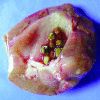Kidney stones
- PMID: 15191979
- PMCID: PMC421787
- DOI: 10.1136/bmj.328.7453.1420
Kidney stones
Figures
References
-
- Asplin JR, Favus MJ, Coe FL. Nephrolithiasis. In: Brenner BM, ed. Brenner and Rector's the kidney. 5th ed. Philadelphia: Saunders, 1996: 1893-935.
-
- Stamatelou KK, Francis ME, Jones CA, Nyberg LM Jr, Curhan GC. Time trends in reported prevalence of kidney stones in the United States: 1976-1994. Kidney Int 2003;63: 1817-23. - PubMed
-
- Parks JH, Barsky R, Coe FL. Gender differences in seasonal variation of urine stone risk factors. J Urol 2003;170: 384-8. - PubMed
-
- Ciftcioglu N, Bjorklund M, Kuorikoski K, Bergstrom K, Kajander EO. Nanobacteria: an infectious cause for kidney stone formation. Kidney Int 1999;56: 1893-8. - PubMed
-
- Curhan GC, Willett WC, Rimm EB, Stampfer MJ. Family history and risk of kidney stones. J Am Soc Nephrol 1997;8: 1568-73. - PubMed
Publication types
MeSH terms
Substances
LinkOut - more resources
Full Text Sources

